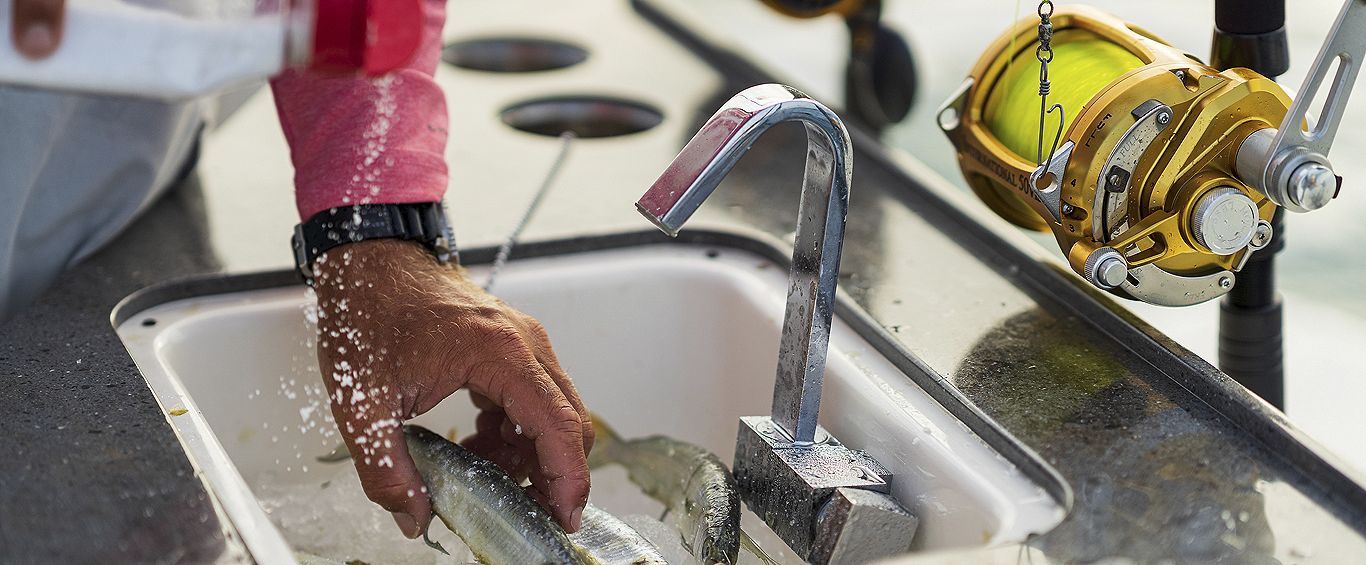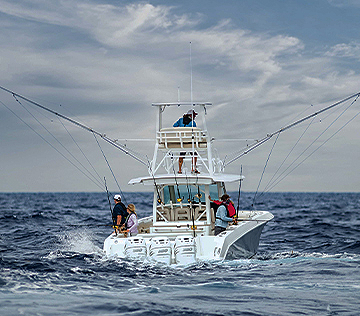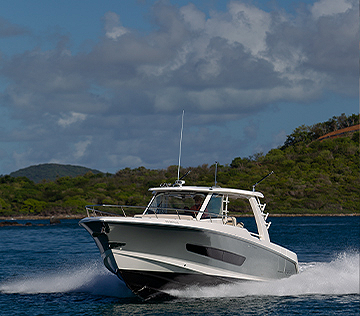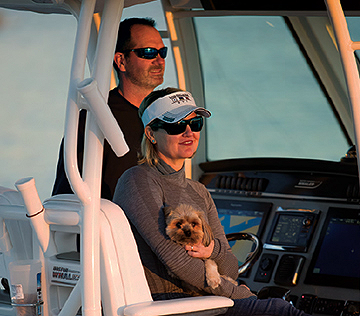
5 Types of Fishing Lures to Keep On Board
With these five artificial fishing lures on board, you’ll be ready to fish anytime, and anywhere.
Not every boat day is intended to be a fishing excursion, but when your guests want to pick up a fresh catch, you want to be ready. It's not always possible or convenient to visit fishing gear or bait shops for live bait. By keeping these five artificial fish lures on board, you’ll be covered in every situation. Whether you’re in saltwater, freshwater, rain or shine, this kit have you set to catch fish!
What are the best fishing lures to use?
When it comes to selecting the best fishing lures, it's important to consider a few factors, such as the type of fish you're targeting and the fishing conditions. Here are some of the most effective lures for various scenarios:
1. White Bucktail Jig
Universally loved by both fresh and saltwater predators, pack a white bucktail jig into your arsenal this summer. The tail skirt creates a steady flow, and the white color imitates many baitfish adding to its life-like presentation. We recommend investing in both a lightweight and a heavyweight bucktail jig. The lightweight option shines in environments like mangroves and flats, while the heavier jig thrives in deeper waters – particularly near structures such as docks and bridges where large fish often hangout.
2. Gold Spoon
Gold spoons can be used in a variety of ways, making them one of the most versatile bait options. Whether you plan to cast and retrieve, troll behind a boat, or even jig your spoon vertically, this bait is both a durable and reliable option. We suggest, but would not limit you to, trying out a gold spoon in darker waters to achieve a stronger glare. Appearing to mimic a wounded bait fish, their reflective surface and vibrating movements can attract the attention of predatory fish in both saltwater and freshwater.
3. Soft Plastic Fluke
Soft plastic flukes make an excellent bait due to their hyper life-like appearance. Featuring a natural profile similar to that of a struggling baitfish. There are plenty of options to select sometimes with added scents, predators are attracted to them in the way they would be a midday snack! A great overall option is a white colored 5” fluke that is either Texas rigged or on a ¼ oz jighead. Commonly mistaken as solely a freshwater fishing lure, soft plastic flukes work great for many saltwater fish – both in and offshore.
4. Crankbaits
Crankbaits come in various shapes and sizes, which affects the lure's movements and diving capabilities. Because of this, you’re going to want to select a crankbait that is a bit more specific to the bait fish your target species is feeding on. A “match the hatch” approach is a sure way to select an appropriate crankbait, for example if the fish are feeding on shad then utilize a crankbait that resembles that prey. While a mid-sized to smaller crankbait is typically suitable for most species, a larger crankbait with a heavier diving lip will be necessary if you're on the hunt for something big. Additionally, during the warm summer months, a larger crankbait can help to provoke more aggressive bites.
5. Spinnerbait
Designed with one plus blades attached to a wire arm, spinnerbaits create flashes, vibrations, and sounds to naturally incite predators. A spinnerbait typically has a rubber or silicone skirt, built to mimic the body of living prey. Available in many colors, select a spinnerbait skirt that mirrors the specific baitfish living in your area. Although rendered as a versatile bait, they are often successful slow rolled over shallow flats, weed beds, and near rocky structures. Attaching a soft plastic trailer not only beefs up the profile of your spinnerbait but adds a realistic addition to your presentation.
Remember that the best lure ultimately depends on the specific fishing situation, so it's a good idea to have a variety of lures in your tackle box.
The Most Common Fishing Lure
While there's no definitive answer to what the "most common" fishing lure is, if we were to pick one that is widely recognized and used by anglers of all levels, it would be the humble spoon lure. Spoon lures are simple in design, with a concave, spoon-like shape that mimics the movement of a wounded baitfish. They come in various sizes and colors, making them versatile for different fish species and water conditions. Spoon lures are known for their effectiveness in both freshwater and saltwater environments.
Is Lure Fishing Harder than Bait Fishing?
The debate over whether lure fishing is harder than bait fishing is ongoing and often subjective. Both methods have their advantages and challenges:
- Lure Fishing: Lure fishing can be seen as more challenging because it requires anglers to actively work the lure to attract fish. It demands a good understanding of fish behavior and the ability to adapt to changing conditions. It can be more physically engaging and may require more skill in some situations.
- Bait Fishing: Bait fishing is often considered more relaxed and accessible, especially for beginners. It relies on using natural or artificial baits to attract fish passively. While it may require less technique, it still involves knowledge of fishing spots and patience.
Ultimately, whether lure fishing is harder than bait fishing depends on your perspective and the specific fishing scenario. Many anglers enjoy both methods and choose based on their preferences and the type of fishing experience they seek.
In conclusion, the best fishing lure for you depends on the fish you're targeting and the conditions you're facing. While there may not be a single "best" lure, the spoon lure is a common and effective choice. As for whether lure fishing is harder than bait fishing, it's all a matter of personal preference and the type of adventure you're looking for on the water. So, grab your favorite lures, head to your favorite fishing spot, and enjoy the thrill of the catch!
Explore Boston Whaler’s incredible line-up of fishing boats! See our model pages to find the best fishing boat for your needs.
--
This is for general information purposes only. Your use or reliance on any of the information in this Blog is solely at your own risk. Under no circumstance will we have any liability for any loss or damage of any kind incurred as a result of the use of any of the information provided.
Options and features mentioned subject to change. Please confirm availability of all accessories and equipment with an authorized Boston Whaler Dealer.



